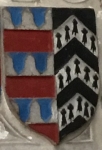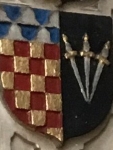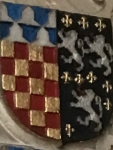Last month I was fortunate enough to give another concert in Devon, this time in the beautiful surroundings of RHS Garden Rosemoor near Great Torrington. Great Torrington was the home of my 14xgreat grandfather Edward Chichester (1496-1522) and I took the opportunity of visiting Pilton Church in Barnstaple where there is a magnificent monument to his son Sir John Chichester of Raleigh (d 1569) who is, I believe, the most recent of my direct ancestors to have his own Wikipedia page. Sir John was the great grandfather of Henry Upton of Castle Upton, Co Antrim and the father of Sir Arthur Chichester, the Lord Deputy of Ireland who oversaw the Plantation of Ulster.
Wikipedia has plenty to say about his career which I need not repeat here, but I’d like to look at the various heraldic escutcheons (shield shapes containing coats of arms) on his monument, some of which are not covered by Wikipedia at the time of writing.
[In heraldry, impalement is the division of a shield by a vertical line, with the dexter half (on the right side from the point of view of the person holding the shield) showing the arms of a husband and the sinister (left) showing the arms of his wife.]

On the right hand side of Sir John Chichester’s tomb is a heraldic panel which is almost a family tree for Sir John, confirming and extending the one given in the 1564 Visitation of Devon. Working backwards we have
 Chichester impaling Bourchier. This represents the marriage of Sir John’s parents, Edward Chichester and Elizabeth Bourchier, daughter of the 1st Earl of Bath. Edward and Elizabeth were distant cousins (see below). No further generations of Bourchiers are represented, probably because Elizabeth was not an heiress, but this was still a prestigious match because the Bourchiers had royal ancestry via the Earl’s great-grandmother, Anne of Gloucester, the daughter of Edward III’s youngest son. I discuss the Bourchiers in this post.
Chichester impaling Bourchier. This represents the marriage of Sir John’s parents, Edward Chichester and Elizabeth Bourchier, daughter of the 1st Earl of Bath. Edward and Elizabeth were distant cousins (see below). No further generations of Bourchiers are represented, probably because Elizabeth was not an heiress, but this was still a prestigious match because the Bourchiers had royal ancestry via the Earl’s great-grandmother, Anne of Gloucester, the daughter of Edward III’s youngest son. I discuss the Bourchiers in this post. Chichester impaling Beaumont. This represents the marriage of Edward’s parents, Sir John Chichester (1472-1538) and Margaret Beaumont. Margaret was the only child of Hugh Beaumont (c1457-1507) who, despite being a sixth son, had ended up being heir to the Beaumont estates in several counties in the southwest. (One of his childless elder brothers had married Blanche Bourchier, the aunt of the Earl of Bath.) On Hugh’s death, however, his daughter’s inheritance was contested by John Bodrigan, the illegitimate son of the wife of Hugh’s eldest brother William Beaumont, and by Hugh’s sister Joan Basset. Although John was the son of William’s widow’s second husband, he was born while she was still married to William. Parliament could not bring itself to declare him a bastard as he was born in wedlock, and in the end the estates were divided among the three claimants. Margaret received Shirwell and Youlston which were thus brought into the Chichester family.
Chichester impaling Beaumont. This represents the marriage of Edward’s parents, Sir John Chichester (1472-1538) and Margaret Beaumont. Margaret was the only child of Hugh Beaumont (c1457-1507) who, despite being a sixth son, had ended up being heir to the Beaumont estates in several counties in the southwest. (One of his childless elder brothers had married Blanche Bourchier, the aunt of the Earl of Bath.) On Hugh’s death, however, his daughter’s inheritance was contested by John Bodrigan, the illegitimate son of the wife of Hugh’s eldest brother William Beaumont, and by Hugh’s sister Joan Basset. Although John was the son of William’s widow’s second husband, he was born while she was still married to William. Parliament could not bring itself to declare him a bastard as he was born in wedlock, and in the end the estates were divided among the three claimants. Margaret received Shirwell and Youlston which were thus brought into the Chichester family. Beaumont impaling Wise. This represents the marriage of Hugh Beaumont and Thomasine Wise, the daughter and heiress of Oliver Wise. The Beaumonts in History states that this marriage took place c1504, but this is at least 25 years out because their daughter had a son in 1495 (Edward’s elder brother Hugh Chichester who pre-deceased his father without issue). In total contrast, Burke’s History of the Commoners of Great Britain and Ireland (1835) claims, equally implausibly, that Oliver was the brother of the High Sheriff of Devon of 1405. I think I’ll need another post to untangle all the misunderstandings with the Wise family.
Beaumont impaling Wise. This represents the marriage of Hugh Beaumont and Thomasine Wise, the daughter and heiress of Oliver Wise. The Beaumonts in History states that this marriage took place c1504, but this is at least 25 years out because their daughter had a son in 1495 (Edward’s elder brother Hugh Chichester who pre-deceased his father without issue). In total contrast, Burke’s History of the Commoners of Great Britain and Ireland (1835) claims, equally implausibly, that Oliver was the brother of the High Sheriff of Devon of 1405. I think I’ll need another post to untangle all the misunderstandings with the Wise family. Beaumont impaling Willington. Hugh’s mother was Alice Stukeley, stepsister of the Earl of Bath’s father, but this escutcheon represents the marriage of Hugh’s grandfather, Sir William Beaumont (1366-1408) and Isabel Willington, sister and heir of John Willington of Umberleigh. She was extremely rich and had many lands according to her IPM in 1424. Umberleigh, though, ended up with Hugh Beaumont’s sister and became the seat of the Bassets.
Beaumont impaling Willington. Hugh’s mother was Alice Stukeley, stepsister of the Earl of Bath’s father, but this escutcheon represents the marriage of Hugh’s grandfather, Sir William Beaumont (1366-1408) and Isabel Willington, sister and heir of John Willington of Umberleigh. She was extremely rich and had many lands according to her IPM in 1424. Umberleigh, though, ended up with Hugh Beaumont’s sister and became the seat of the Bassets. Chichester impaling Paulet. Edward Chichester’s other grandparents were Nicholas Chichester and Christine Paulet, whose nephew William Paulet (c1484-1572) was the 1st Marquess of Winchester. (His grandson or grand nephew Lord George Paulet (1553-1608) went to Ireland, became Governor of Derry, insulted the chieftain Cahir O’Doherty, and was killed in the resulting O’Doherty’s Rebellion.)
Chichester impaling Paulet. Edward Chichester’s other grandparents were Nicholas Chichester and Christine Paulet, whose nephew William Paulet (c1484-1572) was the 1st Marquess of Winchester. (His grandson or grand nephew Lord George Paulet (1553-1608) went to Ireland, became Governor of Derry, insulted the chieftain Cahir O’Doherty, and was killed in the resulting O’Doherty’s Rebellion.) Chichester impaling Keynes. The History of the Family of Chichester states that Nicholas Chichester’s parents were Richard Chichester (1423-1496), whose ledger stone is in the floor of Pilton Church according to Wikipedia (but annoyingly I missed it on my visit), and Margaret Keynes of Winkleigh, so these ought to be her arms. However, these are the arms of Stapledon of Annery, as seen on the tomb in Exeter Cathedral of Walter de Stapledon (d 1326), Bishop of Exeter and founder of Exeter College, Oxford. The Stapledons were succeeded at Annery by the Hankfords and the same arms appear on the tomb of the 3rd Earl of Bath in Tawstock (described in my post about the Bourchiers), there representing the marriage of the 1st Earl’s grandfather to Thomasine Hankford around 1440. The Keynes family of Winkleigh descended from the bishop’s sister Joan Stapledon who married Thomas Keynes.
Chichester impaling Keynes. The History of the Family of Chichester states that Nicholas Chichester’s parents were Richard Chichester (1423-1496), whose ledger stone is in the floor of Pilton Church according to Wikipedia (but annoyingly I missed it on my visit), and Margaret Keynes of Winkleigh, so these ought to be her arms. However, these are the arms of Stapledon of Annery, as seen on the tomb in Exeter Cathedral of Walter de Stapledon (d 1326), Bishop of Exeter and founder of Exeter College, Oxford. The Stapledons were succeeded at Annery by the Hankfords and the same arms appear on the tomb of the 3rd Earl of Bath in Tawstock (described in my post about the Bourchiers), there representing the marriage of the 1st Earl’s grandfather to Thomasine Hankford around 1440. The Keynes family of Winkleigh descended from the bishop’s sister Joan Stapledon who married Thomas Keynes. Chichester impaling Wotton. Richard Chichester’s parents were Sir John Chichester (1385-1437) of Raleigh, who fought at Agincourt, and Alice Wotton, the heiress and daughter of John Wotton of Widworthy. I have no supporting evidence that these are the arms of Wotton, but they are confirmed by other escutcheons on the tomb. The Manor of Widworthy was given to Edward Chichester’s younger half brother. (Elizabeth Bowes-Lyon, the Queen Mother, descends from Richard’s sister Thomasine.)
Chichester impaling Wotton. Richard Chichester’s parents were Sir John Chichester (1385-1437) of Raleigh, who fought at Agincourt, and Alice Wotton, the heiress and daughter of John Wotton of Widworthy. I have no supporting evidence that these are the arms of Wotton, but they are confirmed by other escutcheons on the tomb. The Manor of Widworthy was given to Edward Chichester’s younger half brother. (Elizabeth Bowes-Lyon, the Queen Mother, descends from Richard’s sister Thomasine.) Wotton impaling Dymoke. I do know these are the arms of the Dymoke family, so this shows that Alice’s mother was Engaret Dymoke (not John Wotton’s other wife Joanna Dinham as per the History of the Family of Chichester.)
Wotton impaling Dymoke. I do know these are the arms of the Dymoke family, so this shows that Alice’s mother was Engaret Dymoke (not John Wotton’s other wife Joanna Dinham as per the History of the Family of Chichester.)
Below this heraldic panel are a further pair of escutcheons representing two earlier marital alliances that brought lands into the Chichester family.

Further evidence of the Wotton coat of arms comes from the escutcheon of Wotton impaling Moels. Here’s a family tree of the 14th century Barons Moels suggesting John Wotton descended from Roger de Moels, the 3rd Baron. Muriel Moels in this tree was the maternal grandmother of John Dinham (1359-1428) and he was the paternal grandfather of the Earl of Bath’s mother. This is why Edward Chichester and Elizabeth Bourchier were distant cousins.

 The final escutcheon represents the important marriage between John Chichester and Thomasine Raleigh, the parents of the knight who fought at Agincourt. She was the heiress who brought the Manors of Raleigh and Arlington to the Chichester family. This was the point at which the Chichester family settled in Devon. (Arlington was given to Amias Chichester, another half brother of Edward Chichester and the ancestor of the Chichester baronets of Arlington Court and the Christies of Glyndebourne.)
The final escutcheon represents the important marriage between John Chichester and Thomasine Raleigh, the parents of the knight who fought at Agincourt. She was the heiress who brought the Manors of Raleigh and Arlington to the Chichester family. This was the point at which the Chichester family settled in Devon. (Arlington was given to Amias Chichester, another half brother of Edward Chichester and the ancestor of the Chichester baronets of Arlington Court and the Christies of Glyndebourne.)

This row of alliances starts on the front of the monument where we see from left to right the arms of Chichester, Raleigh impaling Peverell, Raleigh impaling Chandos and Moels impaling Prowse (further proof of John Wotton’s descent from Roger Moels and his wife Alice Prowse.)
We can see in the 1564 Visitation of Devon that Thomasine’s grandfather Sir William Rawley married Beatrix Chandos and Sir William’s grandfather married Laura, daughter and coheir of Sir Hugh Peverell. This marriage is not mentioned in Wikipedia’s entry on the Manor of Raleigh.

(Sir Walter Raleigh and his aunt Johanna were both descendants from Sir William’s second wife, so when Johanna’s grandson Arthur Upton (1564-1617) married Sir John Chichester’s granddaughter Gertrude Fortescue they were very distant cousins.)
So that explains the bottom half of Sir John Chichester’s monument. In my next post I will look at the top half.
